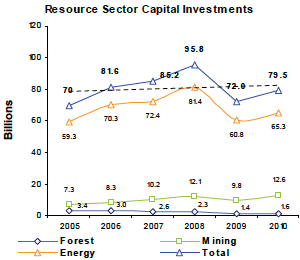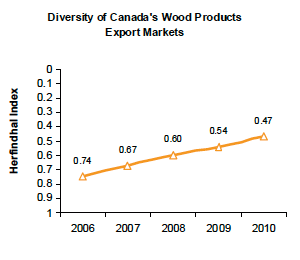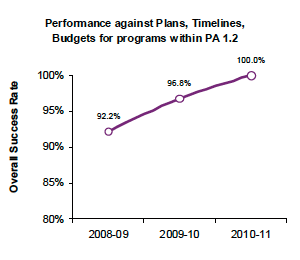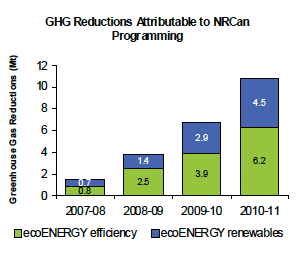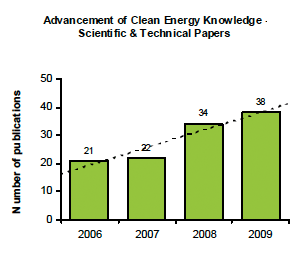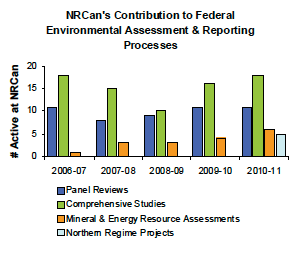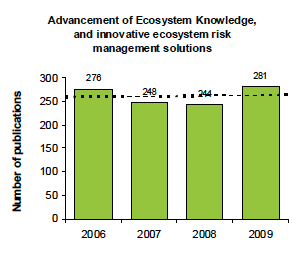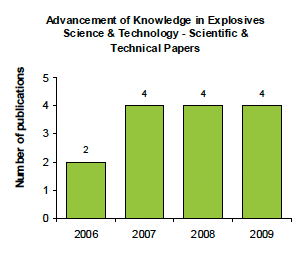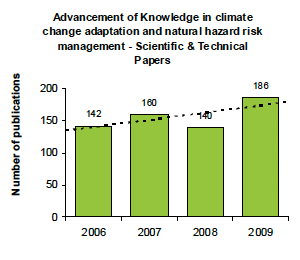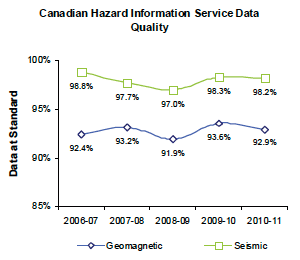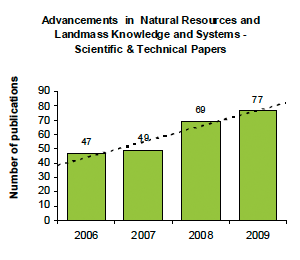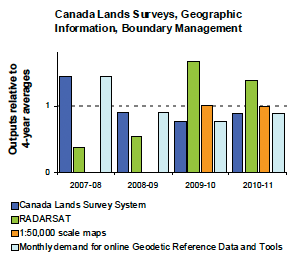Common menu bar links
Breadcrumb Trail
ARCHIVED - Natural Resources Canada - Report
 This page has been archived.
This page has been archived.
Archived Content
Information identified as archived on the Web is for reference, research or recordkeeping purposes. It has not been altered or updated after the date of archiving. Web pages that are archived on the Web are not subject to the Government of Canada Web Standards. As per the Communications Policy of the Government of Canada, you can request alternate formats on the "Contact Us" page.
Section II: Analysis of Program Activities by Strategic Outcome
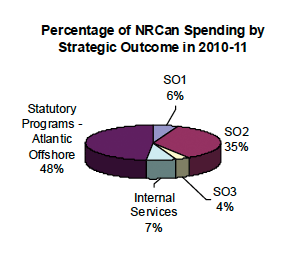 This section provides performance information on the delivery of programs that were critical to the realization of our strategic outcomes and priorities in 2010-11. During the reporting period, NRCan monitored and
tracked progress through quarterly reviews, which enabled early detection of problem areas and, wherever possible, the implementation of corrective actions to deliver expected results in accordance to plans, timelines and budgets.
This section provides performance information on the delivery of programs that were critical to the realization of our strategic outcomes and priorities in 2010-11. During the reporting period, NRCan monitored and
tracked progress through quarterly reviews, which enabled early detection of problem areas and, wherever possible, the implementation of corrective actions to deliver expected results in accordance to plans, timelines and budgets.
NRCan also updated its performance indicators in order to support improved performance management and decision-making, and provide more accurate and balanced performance information to Parliament and Canadians. As a result, performance indicators in this document differ slightly from those published in the corresponding 2010-11 Report on Plans and Priorities.49
More information about these programs and initiatives, as well as supporting evidence from internal evaluation and audit reports, can be found on our website50.
Strategic Outcome 1 - Economic Competitiveness

[Text Version Strategic Outcome 1]
NRCan works to contribute to the economic competitiveness of natural resources by:
- Increasing access to new and existing markets by contributing to the reduction of trade barriers and ensuring that regulations are up-to-date;
- Maximizing productivity and decreasing dependency on the sale of traditional products by encouraging natural resources sectors to adopt new technologies and processes and develop new products; and,
- Encouraging investments in the natural resource sectors by decreasing the risk of development and increasing knowledge on opportunities.
Program Activity 1.1: Economic Opportunities for Natural Resources
Expected Result:
Competitive national and international markets, stable economic opportunity, and investment in natural resources
The program activity contains programs designed to promote innovation, investment, and the enhancement of the competitiveness of Canada's natural resources and related products industries through the provision of know-how and tools, including base geo-science information, along with trade promotion and market acceptance, at home and abroad. This group of programs also delivers policies, regulations and legislative work to manage federal responsibilities associated with Canada's oil and natural gas supply, protecting the critical energy infrastructure, and managing statutory programs for the Atlantic offshore.
| 2010–11 Financial Resources ($ millions) | 2010–11 Human Resources (FTEs) | |||||
|---|---|---|---|---|---|---|
| Planned Spending | Total Authorities | Actual Spending | Planned | Actual | Difference | |
| Program | 248.1 | 263.2 | 248.7 | 835 | 904 | (69) |
| Statutory Programs – Atlantic Offshore Accords | 1676.4 | 2103.3 | 2103.3 | |||
| Performance Indicators | Target | Status | Results |
|---|---|---|---|
| A. Capital investments and exploration investments in the resource sector | Favourable 5-year trend in billions of dollars | Mostly Met |
As Canada is emerging from the global downturn, capital investments in the natural resource sectors are continuing to increase. In 2010, new capital investments in the natural resource sectors accounted for 23.5% of the total capital investments in our economy. The longer term trend for resource sector capital investments is also positive, with data for the 2000-10 period showing an overall favourable trend. |
| B. Diversity of Canada's wood products export markets (as measured by the Herfindahl index for markets) | Favourable 5-year trend | Met All |
Over the period, Canadian wood exports to China have rapidly increased, from less than $50 million in 2000 to more than $834 million in 2010. The diversity of export markets increases the resiliency of the forest sector and allows it to adapt more easily to changing market conditions. The Herfindahl Index presented here is supported by data from Statistics Canada World Trade Atlas. A value of 1.0 indicates only a single receiving country for all of Canada’s exports; as the value moves towards zero, the more Canada has diversified its dependency on one receiving country. |
Performance Summary and Analysis of Program Activity
The level of investment in Canada’s natural resource sectors is a leading indicator of the natural resource sectors’ competitiveness. This Program Activity includes programs aimed at increasing market access, innovation and investments, three critical dimensions of competitiveness. By reducing trade and policy barriers, promoting Canadian products abroad, optimizing the use of our natural resources, increasing productivity and encouraging investments, NRCan is supporting the competitiveness of our natural resource sectors.
The economic downturn of 2008 and 2009 slowed down growth and investments in natural resources. By mid-2009, however, Canada was showing signs of economic recovery and natural resources have proven to be a strong engine of this growth. In fact, 2010 has witnessed an increase in investments in oil and gas and in mining, with capital and exploration investments increasing more than 10% from the
2009 levels. The forest sector is also showing signs of recovery after years of structural and cyclical shocks. Canada’s natural resources will continue to be key contributors to the country’s economy, and the growing demand for natural resources, coupled with higher commodity prices (oil, mineral and metals), is expected to lead to a positive long term trend in investments in natural
resources.
Key achievements in 2010-11 include:
- In support of the forest sector, NRCan’s efforts to diversify export markets for Canadian wood products has helped cushion Canada’s forest sector from what has been a severe contraction over the past few years in its traditional export markets. Programs such as the Canada Wood Export Program51 and the North American Wood First Initiative52 have contributed to the diversification of wood export markets, and have led to an increase in wood exports. Programs such as the Value to Wood Program53 and the Leadership for Environmental Advantage in Forestry have contributed to productivity gains and an increase in the environmental credentials of Canada’s forest products.
- The Geo-mapping for Energy and Minerals54 (GEM) program and the Targeted Geoscience Initiative55 have led to the
discovery of prospective exploration sites. By reducing the exploration risk, these programs are stimulating new mining and energy exploration and development and encouraging investments in Canada’s natural resources.
- Finally, through various regulatory, trade promotion, and policy activities, NRCan promoted investment and competitiveness in the oil and gas sector, which is now the highest revenue-generating sector in the Canadian economy.
Lessons Learned
An evaluation56 of the Forest Innovation and Forest Research Institutes Initiative was completed in 2010. In particular, it included an assessment of the integration of Canadian forest research institutes into the world’s largest forest research organization, FPInnovations57. Findings indicated that these programs are cost-effective, relevant to federal and NRCan priorities, and successful in meeting their expected results. FPInnovations developed a five-year Innovation Strategy in response to a recommendation included in the evaluation to update the long-term research plan for the forest sector in consultation with appropriate stakeholders.
While NRCan’s GEM program was generally successful at ensuring Northerners were involved in all stages of project planning and implementation, improvements were made in 2010-11 to better incorporate community-based knowledge into project planning. Collaborative engagement sessions were held in consultation with regional advisory groups and communities to exchange information and incorporate local knowledge, enhancing program efficiencies and addressing local interests, customs and environmental concerns, such as migration patterns.
Program Activity 1.2: Natural Resource-Based Communities
Expected Result:
Increased knowledge, skills and capacity to benefit from the evolving natural resource economy within resourced-based communities (both Aboriginal and non-Aboriginal)
This program activity is targeted to increase Canada's knowledge of the impacts of the resource sectors on communities that have a substantial reliance on resource-based industries and to improve the capacity and knowledge for increasing the number of opportunities through value-added products and services. This group of programs is designed to improve the social well-being of Canadians. It is also about promoting Aboriginal and non-Aboriginal participation, improving skills, capacity and community stability through, for example, the Forest Community Program, the First Nations Forestry Program, and the Mines Ministers federal/provincial and territorial Framework for Action.
| 2010–11 Financial Resources ($ millions) | 2010–11 Human Resources (FTEs) | ||||
|---|---|---|---|---|---|
| Planned Spending | Total Authorities | Actual Spending | Planned | Actual | Difference |
| 11.8 | 14.1 | 12.7 | 62 | 41 | 11 |
| Performance Indicators | Target | Status | Results |
|---|---|---|---|
| C. Percentage of programs achieving expected results within plans, timelines and budgets58 | 100% of programs delivered on plan, on time, and within budget | Met All |
|
Performance Summary and Analysis of Program Activity
Natural resources are central to the economy of many rural communities across Canada, and the natural resource sectors are among the largest private employers of Aboriginal peoples. While recent economic conditions and broader forest sector restructuring have led to job losses, NRCan is working with natural resources-based communities across Canada to help mitigate and alleviate the short term economic effects of forest sector transition and reduced investments in natural resources. This will strengthen the resiliency of natural resource-based communities and increase their capacity to benefit from an evolving natural resource economy. NRCan supports this through:
- The development and implementation of innovative / leading-edge community economic development projects to help ensure long term economic sustainability;
- Outreach activities in communities to support capacity-building and help create a more positive investment climate; and,
- The development and dissemination of knowledge and information tools about the natural resource sectors and their contribution to the well-being of communities - including Aboriginal engagement - which helps inform decision-making.
For example, the First Nations Forestry Program59 supported partnership projects across Canada in all aspects of sustainable forest management, knowledge and technology transfer, business opportunity facilitation and training support for specialized forestry technical training and work experience. The program successfully leveraged investments from communities and other partners, exceeding the program’s target of generating 1:1 contributions from other funding partners.
The Forest Communities Program60 supported more than 100 community-based economic development projects and initiatives at 11 forest community sites across Canada, with projects ranging from innovative bio-energy/biomass research, development and implementation to youth training and skills development initiatives. The program has also been successful in leveraging investments from partners, exceeding its target of generating 1:1 contributions from other funding partners.
NRCan worked with provincial partners and led a collaborative, multi-stakeholder research project to examine the economic, social and environmental performance of the mining sector in Canada. The report that ensued, Mining Sector Performance Report 1998-200861, can be used by communities to understand the opportunities, challenges and risks associated with resource development and provides a baseline to measure future progress.
Strategic Outcome 2 - Environmental Responsibility
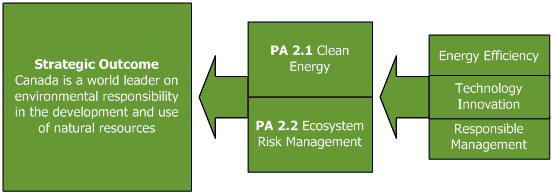
Text Version - Strategic Outcome 2
NRCan works to ensure that natural resources are developed and used in an environmentally responsible manner by:
- Encouraging and enabling energy consumers and producers to adopt cleaner and more efficient technologies, products, services and practices;
- Encouraging academia, industry and the public sector to research, develop and demonstrate innovative solutions to environmental challenges; and,
- Enabling government departments, regulatory bodies and industry to understand the risks to our environment, assess environmental impacts and protect our resources.
Program Activity 2.1: Clean Energy
Expected Result:
Increased energy efficiency, increased production of low-emission energy, and reduced environmental impacts associated with energy production and use
The program activity includes the development and delivery of energy science and technology, policies, programs, legislation and regulations to mitigate air emissions and to reduce other environmental impacts associated with energy production and use. One of the major programs includes the suite of initiatives on clean energy announced under the banner of ecoENERGY, which is intended to increase production of low impact renewable energy; encourage and assist Canadians to improve their energy use in all of the major end-use sectors; and to accelerate the development and market readiness of technology solutions to reduce environmental impacts associated with the production and use of energy.
| 2010–11 Financial Resources ($ millions) | 2010–11 Human Resources (FTEs) | ||||
|---|---|---|---|---|---|
| Planned Spending | Total Authorities | Actual Spending | Planned | Actual | Difference |
| 1,918.7 | 1,895.2 | 1,329.6 | 969 | 966 | 3 |
The variance between the planned and actual spending is mainly attributable to the reprofiling of the funding for key programs such as the Pulp and Paper Green Transformation program and the Clean Energy Fund. These reprofiling have not affected NRCan’s ability to deliver results in 2010-11, as evidenced by the positive performance of its non-financial indicators for Strategic Outcome 2 presented above.
| Performance Indicators | Target | Status | Results |
|---|---|---|---|
| A. Clean energy production and greenhouse gas (GHG) reductions attributable to NRCan programming (in megatonnes of carbon dioxide (CO2) equivalents) | Favourable long-term trend in megatonnes of CO2 equivalents | Exceeded |
This strong performance reflects the significant investments made by the government during that period in initiatives as part of Canada’s Economic Action Plan and other programs. Given a percentage increase of more than 500%, the performance status of Exceeded has been attributed to this indicator. GHG reductions attributable to NRCan's ecoENERGY efficiency and ecoENERGY renewables programming are reported through the horizontal ecoACTION initiative administered by Environment Canada. |
| B. Natural Resources Canada's contribution to advancement of clean energy knowledge, and uptake of innovative clean energy solutions (as measured by number of peer-reviewed publications by NRCan in this field) | Favourable long-term trend in number of publications | Met All |
NRCan’s scientific research on clean energy is highly specialized and well regarded in the world. Some of the ideas and concepts developed will evolve in new products and practices which, when adopted by industry and consumers, will help Canada meet its environmental targets. By funding R&D on clean energy, NRCan is sharing with industry the risks of the development of new or promising technology solutions that may otherwise not be explored or developed. |
Performance Summary and Analysis of Program Activity
In support of energy efficiency, NRCan encouraged and enabled energy consumers and producers to adopt more efficient technologies, products, services and practices. To enable technology innovations, NRCan conducted S&T activities and encouraged academia, industry and the public sector to research, develop and demonstrate innovative solutions to environmental challenges encountered in the natural resource sectors. The objective is to increase energy efficiency, reduce energy costs for Canadians, reduce the emissions of GHGs and other air contaminants and toxic substances arising from energy production, and increase the production and efficient use of renewable energy. In 2010-11, this was achieved through:
- Successful and popular programs under the ecoENERGY Efficiency Initiative (e.g. ecoENERGY Retrofit, ecoENERGY for Buildings and Houses, ecoENERGY for Industry, ecoENERGY for Equipment, ecoENERGY for Fleets and ecoENERGY for Personal Vehicles) which have promoted smarter energy use by Canadians and Canadian firms, thereby reducing GHG emissions. Overall in 2010-11, NRCan’s energy
efficiency programming resulted in energy savings of approximately 82 petajoules, which represents a cumulative annual reduction of more than 6 megatonnes of GHG emissions.
- Other programs under the ecoENERGY banner (e.g. ecoENERGY for Biofuels, ecoENERGY Heat and ecoENERGY Power) have contributed to an increased production of renewable heat and power and increased use of alternative fuels. The renewables programming contributed to reducing GHG emissions by more than four and a half megatonnes in 2010-11. Through the ecoENERGY for Biofuels62 program, 31 contribution agreements were signed to both reduce GHG emissions resulting from fuel use and provide new market opportunities for agricultural producers and rural communities.
Similarly, with support of the ecoENERGY for Renewable Power program, more than 4,458 megawatts of new renewable power generating capacity will contribute to reducing the GHG emissions resulting from electricity generation and to providing local economic opportunities.
- Research, Development and Demonstration activities, in part funded through the Clean Energy Fund63, focussed on a limited set of priorities in the areas of clean fossil fuels; clean integrated electricity including clean coal, carbon capture
and storage, distributed power generation, next generation nuclear; bio based energy systems; low emission industrial systems; clean transportation systems; and the built environment, several of which encompass renewable energy. Progress on specific projects this year include:
- Undertaking the design work on three large-scale Carbon Capture and Storage demonstration projects;
- Providing expert advice to develop regulations under the Canadian Environmental Protection Act to limit greenhouse gas emissions from coal-fired power plants (final publication is expected in 2011-12); and,
- Publishing Canada's Electric Vehicle Technology Roadmap64, which focuses on the development and adoption of electric vehicles in Canada, while building a robust industry.
- The development and testing of new materials, such as high-strength steels and magnesium technologies, with a view of increasing energy efficiency and clean air in the automotive and nuclear sectors (through the Vehicle Structural Materials Program 65 and the Materials for Nuclear and Conventional Energy Program66). In the long term, adoption of new lightweight materials for automotive applications will result in a reduction of GHG emissions (lighter vehicles
meaning less energy consumed, and less GHG emitted).
- The Pulp and Paper Green Transformation Program67, which works to improve environmental performance of Canada’s pulp and paper sector. By investing in capital projects with measurable environmental benefits, the Department is contributing to the generation of a significant amount of new renewable energy, improved energy efficiency for the mills and reduced greenhouse gas emissions in mills across Canada. In addition, by improving the environmental performance of Canadian pulp and paper mills, the program enhances the long-run sustainability on which this industry, and the communities in which it operates, depend.
Lessons Learned
NRCan completed a robust assessment 68 of the effectiveness of its clean energy and energy efficiency initiatives. Overall it concluded that the programs were relevant, making progress towards achieving their expected results, and that they were consistent with government priorities and NRCan’s mandate to support environmentally-responsible natural resources use and reduce GHGs and other air contaminants. Programs were found to have generated significant GHG reductions, created employment and leveraged investments from the provinces and territories.
Conclusions from the assessment formed the basis for developing the next generation of measures, which were announced as part of the 2011 Federal Budget. Building on lessons learned, improvements were made in the planning and design phase of the new measures, including broader communication and consultation with key stakeholders.
Furthermore, several program-specific evaluations were completed, including in the transportation energy efficiency area. Most of the findings indicated that the programs in this area were relevant and were achieving their expected results. To address recommendations from the evaluation, NRCan clarified its performance measurement strategy to better track its results and ensure proper reporting on outcomes.
In addition, the evaluation69 of the NRCan’s renewable energy programs concluded that Wind Power Production Incentive (WPPI) and the ecoENERGY for Renewable Power Program have contributed to the growth of the renewable power industry. The ecoENERGY for Renewable Heat Program may have increased the capacity of the industry to deliver quality renewable heat systems into the Canadian market but the industry remains small, without many of the attributes of a mature industrial sector.
The evaluation70 of the Energy Efficiency for Industry, Housing and Buildings initiatives found the ecoENERGY Retrofit – Homes program to be highly effective at expanding or modifying the energy retrofit activities of homeowners, leading to program participants undertaking double the number of retrofits originally planned, with 60% being motivated to undertake further measures outside of the program. The program was found to be relevant and responding to the priorities of government, and had the unintended outcomes of creating jobs in the energy consultant sector and triggering the creation of energy-efficient housing programs in several provinces.
NRCan also completed an audit71 of the Pulp and Paper Green Transformation Program, which concluded that the program’s management and control were operating well. Recommendations were made to implement the Program's recipient audit strategy and formally develop and promulgate service standards. NRCan responded to this recommendation by completing the Program recipient audit strategy and establishing service standards that have been communicated to proponents.
Program Activity 2.2: Ecosystem Risk Management
Expected Result:
Canada understands and mitigates risks to natural resource ecosystems and human health
The program activity includes programs that help to understand the risks to our environment. A major program is the National Forest Inventory, which is designed to provide information to provinces, territories, other collaborators and the public on the state of Canada’s forests, demonstrating how forest attributes are changing over time through an internet application.
| 2010–11 Financial Resources ($ millions) | 2010–11 Human Resources (FTEs) | ||||
|---|---|---|---|---|---|
| Planned Spending | Total Authorities | Actual Spending | Planned | Actual | Difference |
| 205.7 | 203.3 | 198.3 | 396 | 295 | 101 |
| Performance Indicators | Target | Status | Results |
|---|---|---|---|
| A. NRCan's contribution to federal environmental assessments, forest, mineral and energy resource assessments for proposed protected areas on federal lands and waters, and related reporting processes72 | Fulfilling on-demand requirements | Met All |
|
| B. NRCan’s contribution to advancement of ecosystem knowledge, and innovative ecosystem risk management solutions (as measured by number of peer-reviewed publications by NRCan in this field) | Favourable long-term trend in number of publications | Met All |
Greater knowledge of risks and environmentally responsible practices can help prevent and reduce the environmental impacts of past, present and future natural resource development. By developing and sharing knowledge in this area, NRCan is enabling government departments, regulatory bodies and industry to assess these impacts to the environment; and develop, monitor and maintain resources or clean up wastes responsibly. |
Performance Summary and Analysis of Program Activity
NRCan contributed to risk management for natural resource ecosystems and human health by creating and disseminating knowledge that is critical to decision-making on environmental stewardship, conservation and protection. This contributed to the health and quality of life of Canadians, as well as the sustainability of their natural resources. NRCan achieves this by:
- Contributing to federal environmental assessment and reporting processes, including the provision of geoscience and mining S&T knowledge and expertise to ensure that environmental impacts are identified and mitigated on major resource project environmental assessments.
- Partnering with key stakeholders to protect ecosystems through the advancement of green mining technologies and the Green Mining Initiative.
- Advancing Canada’s forest-related interests relative to the United Nations Framework Convention on Climate Change73 by, for example, further developing and applying the Carbon Budget
Model74, which is now being used both within Canada and internationally to monitor and forecast changes in forest carbon at the national and sub-national level.
- Mapping and assessing key aquifers in Canada to support the responsible development of Canada’s natural resources and inform decision-making on groundwater management issues.
- Ensuring waste management, environmental restoration, and decommissioning priorities at AECL sites through the Nuclear Legacy Liabilities Program75, which aims to safely and cost-effectively reduce legacy liabilities and associated risks at these sites.
Lessons Learned
An audit76 of the Nuclear Legacy Liabilities Program was completed. Overall it was found that the program was well managed and well controlled. Opportunities for improvement were noted in the areas of public consultations and reporting requirements. To address this, NRCan completed public consultations and began work with AECL to streamline reporting and strengthen program management.
Strategic Outcome 3 - Safety, Security and Stewardship
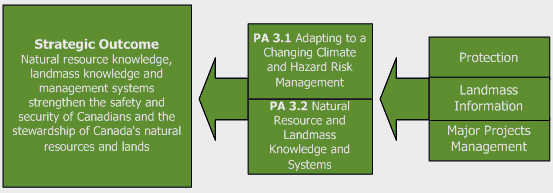
Text Version - Strategic Outcome 3
NRCan works to ensure the safety and security of Canadians and the stewardship of their natural resources by:
- Enabling the government, communities and the private sector to reduce the risks from natural and man-made hazards by providing regulation and knowledge, fulfilling legislated responsibilities, and ensuring capacity;
- Providing clearly-defined legal boundaries, a robust property system framework, authoritative geographic infrastructure and fundamental geospatial information on Canada’s landmass in order to support the Canadian public and stakeholders in location-based decision-making; and,
- Provide oversight of major natural resource projects, including proper environmental protection.
Program Activity 3.1: Adapting to a Changing Climate and Hazards Risk Management
Expected Result:
Canada adapts to a changing climate and has the knowledge and tools to manage risks associated with natural hazards and hazards arising from human activities
The program activity provides geoscience and geospatial information that contributes to the reduction of risks from natural hazards, such as earthquakes, tsunamis and flood, as well as hazards arising from human activities, and works with front-line responders to provide geographical information in the event of an emergency. The program activity also provides information that will help Canadians mitigate and adapt to the effects of a changing climate and administers and enforces the Explosives Act.
| 2010–11 Financial Resources ($ millions) | 2010–11 Human Resources (FTEs) | ||||
|---|---|---|---|---|---|
| Planned Spending | Total Authorities | Actual Spending | Planned | Actual | Difference |
| 68.6 | 67.6 | 60.8 | 576 | 491 | 85 |
| Performance Indicators | Target | Status | Results |
|---|---|---|---|
| A. NRCan’s contribution to the safe and secure use of explosives in Canada | Favourable long-term trend in number of publications | Met All |
Explosives are essential to many economic activities, but are inherently dangerous. Knowledge, combined with strict controls, increase the protection of Canadians from incidents that could result in death, serious injuries and/or economic or environmental harm. |
| B. NRCan's contribution to climate change adaptation and natural hazard risk management as measured by the uptake of adaptation knowledge | Favourable long-term trend in number of publications | Met All |
NRCan’s scientific activities and the dissemination of knowledge on climate change adaptation and natural hazard risk management serve to inform decision-making by industry and various levels of government. Risks can be better assessed and mitigation strategies put in place to ensure the safety and security of Canadians (e.g. mitigation and adaptation strategies related to climate change, earthquakes, tsunamis, geomagnetic storms, etc.). |
|
C.
NRCan's contribution to natural hazard risk management as measured by the timeliness and accessibility of natural hazard risk management knowledge77 |
Greater than 90% of natural hazard data meets timeliness and accessibility standards | Exceeded |
The provision of this information helps other levels of government, including international government bodies, the private sector and professional organizations to prepare for and mitigate natural disasters and make decisions for the effective management of Canada’s lands. |
Performance Summary and Analysis of Program Activity
NRCan contributed to the increase of scientific knowledge on explosives, climate change adaptation and natural hazard risk management, contributing to the safety and security of Canadians and the effectiveness of the stewardship of our land and resources. NRCan accomplished this by:
- Supporting the collaboration of key decision-makers across Canada in assessing the impacts, risks and opportunities of climate change on Canada’s forests and lands. This information is used to develop mitigation and adaptation strategies with partners and stakeholders. The Regional Adaptation Collaborative80 Program, for example, facilitates the development of region-specific adaptation policies and strategies, and brings together provincial and territorial agencies representing different climate-sensitive policy areas.
- Developing strategies, in collaboration with partners, for the management and mitigation of forest disturbances including wildland fires (through the enhanced Canadian Forest Fire Danger Rating System81) and pests (through the National Forest Pest Strategy82).
- Continuing to update Canada’s explosives regulations to reflect modern industrial practices (with an expected publication date in late 2011 or early 2012).
- Providing natural hazard data that informs Canadians and technical specialists of important geophysical parameters, with a view of improving the understanding and management of hazards arising from natural causes, such as earthquakes, and potential interferences with power transmission and telecommunications due to solar storms.
- Publishing the results of its scientific activities and ensuring the dissemination of knowledge on explosives, climate change adaptation and natural hazard risk management. NRCan’s scientific output in these areas was more often cited than the world average, outlining the Department’s scientific impact, as reported in a study conducted by Science-Metrix in 2011.
Lessons Learned
NRCan completed an evaluation83 of the Explosives Safety and Security Branch. Most of the findings revealed that the Branch is achieving its expected results and has demonstrated a high level of effectiveness and efficiency. Recommendations were made to improve performance measurement and to establish strategic partnerships with respect to the security-related aspects of the Branch’s mandate. To address this, the Branch developed a Performance Measurement Framework and established a formal partnership with Defence Research Development Canada to improve cooperation between the two organizations on security-related issues.
NRCan also completed an evaluation84 of various programs relating to the mitigation of forest disturbances including the National Forest Pest Strategy Program. Overall, findings indicated that the programs are being delivered in an efficient manner and are achieving expected results. Recommendations were made to address attrition of scientific staff and fill research gaps in order to update decision-making tools. NRCan has recognized the need to fill these gaps and ensure the dissemination and exchange of knowledge with its various stakeholders, which it will address through the development of a revised Strategic Plan for Forest Disturbances.
A report85 to Parliament by the Commissioner of the Environment and Sustainable Development examined the ability of various departments, including NRCan, to adapt to climate change impacts. Impacts are most evident in Canada’s North where, for example, thawing permafrost is affecting the stability of roads, buildings, pipelines, and other infrastructure. Recommendations were made for departments to identify the adaptation measures necessary to respond to climate change risks within their areas of responsibility, based on an assessment of risks. NRCan undertook a Climate Change Sensitivity Assessment in 2009 and 2010 and continues to monitor risks and changes on an ongoing basis.
Program Activity 3.2: Natural Resources and Landmass Knowledge and Systems
Expected Result:
Government has the necessary natural resources and landmass knowledge and systems required to both govern the country and position Canada to play a leadership role in federal/provincial/territorial and international fora.
This program activity carries out the Minister's obligation to provide a property rights infrastructure on all lands for which the Department has this responsibility, along with the provision and access to accurate and precise geographic information on the Canadian landmass. The program activity also includes the Major Projects Management Office which, along with other programs, provides relevant accurate, timely and accessible knowledge with a view to increasing collaborative efforts with other jurisdictions in key areas (i.e. regulatory efficiency) to generate improved approaches to shared issues and lead significant benefits to advance the interests of the natural resources sector both domestically and at the international level.
| 2010–11 Financial Resources ($ millions) | 2010–11 Human Resources (FTEs) | ||||
|---|---|---|---|---|---|
| Planned Spending | Total Authorities | Actual Spending | Planned | Actual | Difference |
| 103.6 | 98.9 | 95.5 | 670 | 636 | 34 |
| Performance Indicators | Target | Status | Results |
|---|---|---|---|
| A. NRCan's contribution to the development and security of Canada through advancements in landmass knowledge and systems. | Favourable long-term trend in number of publications | Met All |
NRCan’s scientific expertise in this area is well known and recognized around the world: its publications are more often cited than the world average (as reported in a study commissioned by NRCan from Science-Metrix). Furthermore, the knowledge produced is used to support various location-based applications (such as GPS) and decision-making (such as the preparation of Canada’s submission to UNCLOS). |
| B. NRCan's contribution to the development and security of Canada through advancements in boundary management, surveys and supporting systems for secure land tenure of Canada Lands. | Fulfilling on-demand requirements | Met All |
The outputs of these programs and activities are used by Aboriginal groups, land management specialists, other government departments and Canadians in support of sustainable land use management. |
| C. Effective management of the federal regulatory process for major natural resource projects as measured by adherence to target timelines and service standards by all federal departments and agencies. | Greater than 80% of active or completed MPMO projects are within eight weeks of target timeline | Met All | 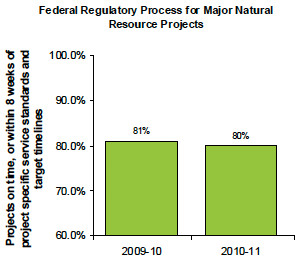 NRCan met its target of 80% for active and/or completed projects that were on time or within eight weeks of their target timelines. Over that period, NRCan managed the federal review process for 70 projects – a 24% increase from the previous year. Effective and efficient project reviews are critical to ensure the responsible development of Canada’s natural resources and lands, including strong environmental protection. |
Performance Summary and Analysis of Program Activity
NRCan’s programs provide clearly defined legal boundaries, a robust property system framework, authoritative geographical infrastructure and fundamental geospatial information on Canada’s landmass. These frameworks and information are essential to the Canadian economy, environment and standard of living. Equally important is NRCan’s work to improve the performance of the federal regulatory system. This was achieved in 2010-11 by:
- Providing accurate and accessible geographicinformation88 to facilitate land tenure and boundary management. For example, by working with the United States Geological Survey, NRCan rendered accessible online current and historic (as far back as 1984) LANDSAT89 imagery, free of charge. This information will enable a more comprehensive analysis of Canada’s lands and coastlines for a variety of economic, environmental and social development activities.
- Mapping and surveying the Arctic seabed to support Canada’s submission to extendits continental shelf beyond the customary 200 nautical miles, as per the United Nations Convention on theLaw of the Sea (UNCLOS). Data collection is proceeding on schedule and current funding levels are projected to be fully adequate.
- Overseeing major resource project reviews (through the Major Projects Management Office90)to strengthen accountability and ensure transparent and timely project reviews as well as implementing system-wide improvements to facilitate investments for
resource development while maintaining strong environmental protection. In particular, efforts were made this year to:
- Develop a whole-of-government strategy to modernize the regulatory review process for natural resource projects;
- Support the implementation of targeted amendments to the Canadian Environmental Assessment Act91 that have resulted in simpler, clearer review processes that improve environmental protection and provide greater certainty to
industry;
- Create new Participant Funding Programs for the National Energy Board and Canadian Nuclear Safety Commission that allow for more timely and meaningful engagement of the public and Aboriginal groups;
- Implement additional policy and operational measures to align the Crown’s Aboriginal consultations activities with the Government of Canada’s Updated Guidelines for Federal Officials on Aboriginal Consultation and Accommodation92; and,
- Advancing two pilot projects (the Line Creek Coal Mine Expansion93 and the Northwest Transmission projects) with the province of British Columbia to help identify opportunities to improve the integration of federal and provincial review processes.
- Develop a whole-of-government strategy to modernize the regulatory review process for natural resource projects;
Lessons Learned
An evaluation94 of NRCan’s national geographic databases was completed. Findings indicated that most of the database components have achieved their intended outcomes and performance targets. Recommendations were made to develop a strategy to implement a comprehensive rights management system (marine cadastre) for offshore Canada Lands. To address this, NRCan is currently performing a feasibility study and stakeholder consultations, which are expected to be completed in March 2012.
NRCan also completed an evaluation95 of GeoConnections (Phase II). Findings indicated that the program has made progress towards achieving its expected results. Recommendations were made to ensure that the local expertise currently being developed by the program can be sustained and transferred to a broader federal and/or provincial-territorial (FPT) level. To address this, NRCan has ensured that future GeoConnections initiatives will involve the coordination of FPT organizations that support the transfer of knowledge.
Program Activity 3.3: : Geomatics Canada Revolving Fund
Expected Result:
The demand by NRCan, other government departments and industrial clients for revolving fund products and services is met through full cost
The Geomatics Canada Revolving Fund was established under Appropriation Act No. 3 in 1993-94. The fund allows Geomatics Canada to shift the costs from taxpayers at large to specific users who benefit directly from the goods and services provided. This revenue retention mechanism gives Geomatics Canada the ability to recover full costs from Canadian customers and the freedom to charge market prices for international clients. It presents the opportunity to provide an increasing volume of products and services in response to the needs of Canadian clients as well as supporting the Canadian geomatics industry through the knowledge and expertise necessary to be competitive in the international market. As part of the Revolving Fund, NRCan produces accurate aeronautical charts and publications for NavCanada as an essential contribution to the safety and security of the traveling public and Canadians.
| 2010–11 Financial Resources ($ millions) | 2010–11 Human Resources (FTEs) | ||||
|---|---|---|---|---|---|
| Planned Spending | Total Authorities | Actual Spending | Planned | Actual | Difference |
| 1.9 (1.9) |
7.3 | (0.3)* | 0 | 10 | (10) |
* Actual spending for Geomatics Canada Revolving Fund was a surplus of $0.3M
| Performance Indicators | Target | Status | Results |
|---|---|---|---|
| A. Percentage rate of service and production costs fully recovered96 | Full cost recovery. | Met All | 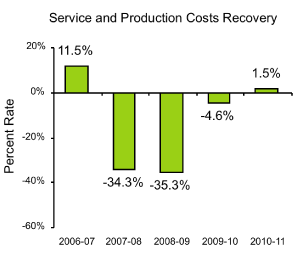 For 2010-2011, NRCan has met its target as a result of the continued success of the Satellite line of business and a successful transition to a new mapping business model. From 2007 to 2010, Geomatics Canada Revolving Fund invested its accumulated surplus to implement a more cost-effective and efficient service and product delivery model. |
Program Activity 4.1: Internal Services
This program activity regroups three sub-activities which assist NRCan in delivering on its mandate and priorities: governance and management support, resource management services, and asset management services. The key to the effectiveness and efficiency of this program activity has been the ability of internal services to adjust and respond to evolving business priorities and requirements. This has allowed the Department to better align its priorities to those of Canadians, its activities to its priorities, and its resources to its activities. It has also increased its capacity to monitor the financial and non-financial performance of its activities and programs.
In 2010-11, the Department established four medium-term corporate priorities: Asserting our policy leadership, Mobilizing our science, Transforming our business and Growing our human capital. These will ensure that the Department focuses on developing its capacity, responsiveness and resilience to maximize its contribution to the Government of Canada and to Canadians.
| 2010–11 Financial Resources ($ millions) | 2010–11 Human Resources (FTEs) | ||||
|---|---|---|---|---|---|
| Planned Spending | Total Authorities | Actual Spending | Planned | Actual | Difference |
| 223.0 | 310.4 | 308.4 | 1,063 | 1,287 | (224) |
The variance between the planned and actual spending can be explained by transfers from departmental programs to internal services as part of the corporate costing model, as well as increased costs associated with the Employee Benefit Plan.
Delivering on Canada's Economic Action Plan (EAP)
NRCan received funding for new and expanded initiatives to deliver on Canada’s EAP, as part of Budget 2009. Total funding received for 2010-11 for EAP initiatives was $657.5 million, of which the Department spent $625.5 million, or 97 percent. EAP initiatives, along with their respective budget and expenditures as of March 31, 2011, are presented below.
| Expected Results | Indicators | 2010-11 ($ million) | |||
|---|---|---|---|---|---|
| Budget | Actual | ||||
| Expanding Market Opportunities (Canada Wood Exports (CWEP), Value to Wood, North American Wood First (NAWFP) Programs) | |||||
| Increase market opportunities for Canadian wood product producers through market development, branding, and technology development and transfer activities | Diversified markets for Canadian wood products; use of wood in North American, non-residential construction new markets for Canadian manufacturers of value-added wood products | 20.7 | 18.7 | ||
| Performance status: In 2010-11, the Canada Wood Export Program97 continued to successfully expand Canadian wood exports to emerging offshore markets. Wood exports to China, for example, rose 119% to $834 million while exports to South Korea rose 47% to reach $145 million. For its part, the North American Wood First Initiative98 influenced the use of wood in 256 non-residential construction projects in Canada and the United States. These projects had an estimated wood sales value of $190 million. The Value to Wood Program99 funded 25 research projects in 2010-11 at five research organizations across Canada that are focused on developing new and improved products and manufacturing processes. As part of the program's technology transfer component, 694 mill visits and technical assessments were performed, which resulted in 249 technical projects that provided direct problem solving support to wood product firms across Canada. | |||||
| Expanding Market Opportunities (Support large-scale demonstrations of Canadian-style use of wood in offshore and domestic markets) | |||||
| Support initiatives to increase market opportunities for Canadian wood product producers in international (e.g., CWEP) and domestic (e.g., NAWFP) markets | Demonstration projects support initiatives to increase non-traditional uses of wood in offshore and domestic markets | 5.7 | 5.2 | ||
| Performance Summary: In 2010-11, the Large Scale Wood Demonstrations Initiative100 supported seven domestic wood demonstration projects (three in British Columbia, one in Ontario, and three in Quebec), with a view to showcase the innovative use of wood in commercial and residential applications. The Initiative also completed four offshore demonstration projects (one in Italy, three in China) that were started in 2009-10. These projects include the construction of wood/concrete hybrid buildings, commercial mid-rise buildings, and buildings which demonstrate the energy efficiency gained by using wood frame construction. | |||||
| Promoting Forest Innovation and Investment (Development of demonstration-scale pilot projects of new products for use in commercial applications) | |||||
| Construction of demonstration-scale pilot projects brings research to the next stage towards commercialization | Operating pilot plants to prove the scalability of new technologies from laboratory to commercial application | 37.0 | 35.4 | ||
| Performance Summary: Research under the Transformative Technologies Program101 (TTP) is advancing the commercialization of new and innovative forest products. The goal of the demonstration-scale pilot program is to move TTP research from the laboratory to the marketplace, a critical step in achieving its employment and economic potential. In 2010-11, fourteen pilot scale demonstration projects were implemented at forest product manufacturing mills across Canada, in partnership with both industry proponents and provincial partners. | |||||
| Promoting Forest Innovation and Investment (Contributions to FPInnovations for its Transformative Technologies Program) | |||||
| To develop emerging and breakthrough technologies related to forest biomass utilization, nanotechnology and next generation forest products | New products and processes adopted by industry; new demonstration/pilot projects and trials; in-kind contributions leveraged from stakeholders; research institute consolidation | 43.5 | 43.1 | ||
| Performance Summary: Federal contributions in 2010-11 enabled the completion of the merger of three separate forestry research institutes into FPInnovations,102 resulting in a strong and integrated public-private partnership for innovation in the forest sector. Federal funding also supported research under the TTP, which looks to develop new technologies and processes which have the potential to create significant employment opportunities for Canada’s forest sector and other manufacturing industries. The resulting knowledge from this research is being published, presented, and transferred to sector stakeholders. The program also successfully leveraged $3.3 million (or 13%) in funding from other sources (i.e., provinces, industry and other federal partners) to deliver on collaborative projects and establish and support research networks. | |||||
| Clean Energy Fund | |||||
| Support the development and demonstration of clean energy technologies | Number of demonstrated technologies that meet or surpass current best technologies; number of knowledge products made available to codes and developed standards; number of technology demonstrations leading to commercialization (long-term outcome) | 121.5 | 114.2 | ||
| Performance Summary: Design work has commenced on the 3 large-scale Carbon Capture and Storage (CCS) demonstration projects announced in 2009-10. The first of these projects is currently under construction and expected to start-up operations in 2012, while the other 2 are expected to start construction in 2012-13 and to start-up operations in 2015. These CCS projects are part of Canada’s contribution to the G8 Leaders’ goal of launching 25 such projects in the future. In addition, 19 small-scale renewable and clean energy projects are underway. As part of the global effort to advance CCS technology, Canada is participating in a number of initiatives, including project knowledge sharing, public outreach, and regulatory development, and is sharing information widely with other governments, including the US (via the Canada-US Clean Energy Dialogue) the EU, Australia, etc. These projects are expected to provide short and medium term economic stimulus and are being tracked as part of Canada’s Economic Action Plan. | |||||
| ecoENERGY Retrofit – Homes program | |||||
| To encourage homeowners to improve the energy efficiency of their homes and reduce their greenhouse gas (GHG) emissions | Grant applications received; grant amounts paid; number of grants paid; GHG emission reductions; pre-retrofit assessments | 351.8 | 351.0 | ||
| Performance Summary: As of March 31, 2011, the ecoENERGY Retrofit – Homes103 program had received over 510,000 grant applications from Canadian homeowners, surpassing the program target of 460,000. Overall, a reduction of approximately 1.75 Mt in GHG emissions has been achieved by program participants, exceeding the program’s target range of 1.29 to 1.66 Mt. In order to respect budget limits, entrance into the program ended March 31, 2010 and a cushion of funding was used to meet high end-of-program demand. Over the course of the program, more than $700 million in grants was paid out to homeowners. | |||||
| Modernizing Federal Laboratories | |||||
| Maintenance and modernization of NRCan laboratories across Canada | Percentage of program funding contracted/awarded or out to tender for bids; percentage of funding not yet contracted/awarded nor out to tender | 30.7 | 30.5 | ||
| Performance Summary: The Modernizing Federal Laboratories initiative allowed NRCan to address key maintenance and science delivery deficiencies in its major research centres across Canada. The projects were delivered on time and within budget, concurrently improving the overall portfolio condition index from poor to fair, providing economic stimulus and improving conditions for the continuing scientific research undertaken at NRCan. | |||||
| Accelerating the Federal Contaminated Sites Action Plan | |||||
| Conducting site assessments, remediation and risk management activities on federal contaminated sites | Number of assessment projects planned, underway or completed; number of remediation/risk management projects planned, underway or completed | 12.7 | 9.1 | ||
| Performance Summary: The Booth Street Complex was a known contaminated site registered in the Federal Contaminated Sites Inventory (FCSI). With the Federal Contaminated Sites Action Plan104 (FCSAP), NRCan was able to remediate the site, improve the environment, reduce environmental liability and stimulate the economy for Canadians. The project was delivered on-time within the two year time frame and was under the expected budget. | |||||
| Maintaining or upgrading existing Arctic research facilities | |||||
| Modernized and expanded logistics base in Resolute to support increased demands for Arctic logistics | Percentage of improved and upgraded logistics base completed | 9.0 | 9.0 | ||
| Performance Summary: The Arctic Research Infrastructure Fund and Modernizing Federal Laboratories initiative have been completed on schedule and on budget. The Arctic facility is operational and has already hosted the Department of National Defence’s annual Arctic Operators Advisor course | |||||
| Investments in Forest Industry Transformation (IFIT) | |||||
| Support forest industry transformation by investing in projects deploying innovative technologies that lead to a more diversified, higher-value product mix including bio-energy and renewable power, as well as biomaterials, bio-chemicals, and next generation building products | Program funds committed to selected projects, total number of proposals received, total number of project proposals approved, number of new installations built or modified OR number of new technologies/innovative applications in place at pilot or commercial scale, percentage of project proposals that involve collaboration with other sectors, number of contribution agreements in place, funds leveraged from other sources. | 24.9 | 11.0 | ||
| Performance Summary: The IFIT program was initiated in the summer of 2010. The program’s first call for proposals round received 64 project applications and was highly oversubscribed. Four innovative projects proposing new technologies leading to production of higher value products (bio-energy solid & liquid, bio-chemicals, renewable power and advanced engineered wood products) were selected for implementation. Contribution agreements were developed with two projects and program funding was provided. Further due diligence steps were required on the larger, more complex projects. The projects selected will also demonstrate new partnerships and business models in the forest industry. | |||||

